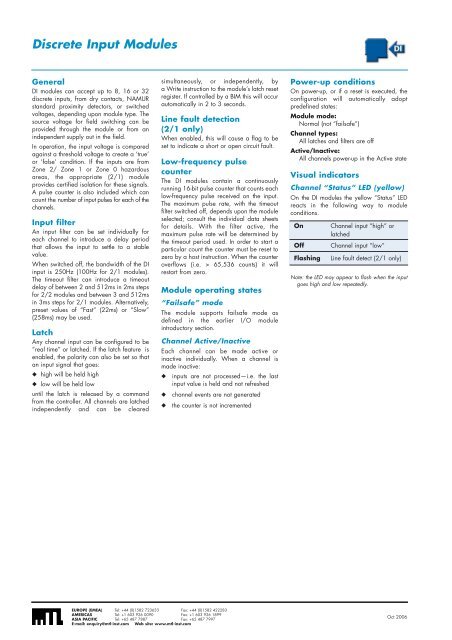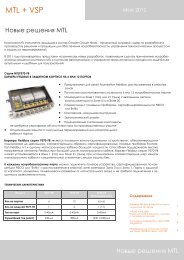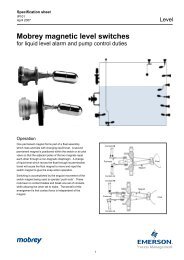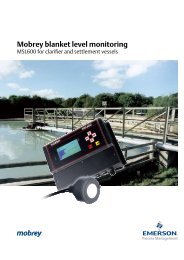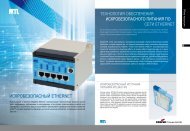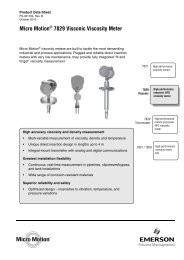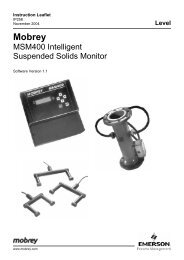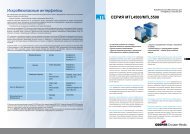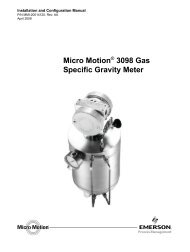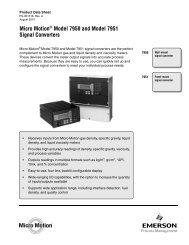You also want an ePaper? Increase the reach of your titles
YUMPU automatically turns print PDFs into web optimized ePapers that Google loves.
Discrete Input ModulesGeneralDI modules can accept up to 8, 16 or 32discrete inputs, from dry contacts, NAMURstandard proximity detectors, or switchedvoltages, depending upon module type. Thesource voltage for field switching can beprovided through the module or from anindependent supply out in the field.In operation, the input voltage is comparedagainst a threshold voltage to create a ‘true’or ‘false’ condition. If the inputs are fromZone 2/ Zone 1 or Zone 0 hazardousareas, the appropriate (2/1) moduleprovides certified isolation for these signals.A pulse counter is also included which cancount the number of input pulses for each of thechannels.Input filterAn input filter can be set individually foreach channel to introduce a delay periodthat allows the input to settle to a stablevalue.When switched off, the bandwidth of the DIinput is 250Hz (100Hz for 2/1 modules).The timeout filter can introduce a timeoutdelay of between 2 and 512ms in 2ms stepsfor 2/2 modules and between 3 and 512msin 3ms steps for 2/1 modules. Alternatively,preset values of “Fast” (22ms) or “Slow”(258ms) may be used.LatchAny channel input can be configured to be“real time” or latched. If the latch feature isenabled, the polarity can also be set so thatan input signal that goes:◆ high will be held high◆ low will be held lowuntil the latch is released by a commandfrom the controller. All channels are latchedindependently and can be clearedsimultaneously, or independently, bya Write instruction to the module’s latch resetregister. If controlled by a BIM this will occurautomatically in 2 to 3 seconds.Line fault detection(2/1 only)When enabled, this will cause a flag to beset to indicate a short or open circuit fault.Low-frequency pulsecounterThe DI modules contain a continuouslyrunning 16-bit pulse counter that counts eachlow-frequency pulse received on the input.The maximum pulse rate, with the timeoutfilter switched off, depends upon the moduleselected; consult the individual data sheetsfor details. With the filter active, themaximum pulse rate will be determined bythe timeout period used. In order to start aparticular count the counter must be reset tozero by a host instruction. When the counteroverflows (i.e. > 65,536 counts) it willrestart from zero.Module operating states“Failsafe” modeThe module supports failsafe mode asdefined in the earlier I/O moduleintroductory section.Channel Active/InactiveEach channel can be made active orinactive individually. When a channel ismade inactive:◆ inputs are not processed—i.e. the lastinput value is held and not refreshed◆◆channel events are not generatedthe counter is not incrementedPower-up conditionsOn power-up, or if a reset is executed, theconfiguration will automatically adoptpredefined states:Module mode:Normal (not “failsafe”)Channel types:All latches and filters are offActive/Inactive:All channels power-up in the Active stateVisual indicatorsChannel “Status” LED (yellow)On the DI modules the yellow “Status” LEDreacts in the following way to moduleconditions.OnOffFlashingChannel input “high” orlatchedChannel input “low”Line fault detect (2/1 only)Note: the LED may appear to flash when the inputgoes high and low repeatedly.EUROPE (EMEA) Tel: +44 (0)1582 723633 Fax: +44 (0)1582 422283AMERICAS Tel: +1 603 926 0090 Fax: +1 603 926 1899ASIA PACIFIC Tel: +65 487 7887 Fax: +65 487 7997E-mail: enquiry@mtl-inst.com Web site: www.mtl-inst.comOct 2006


